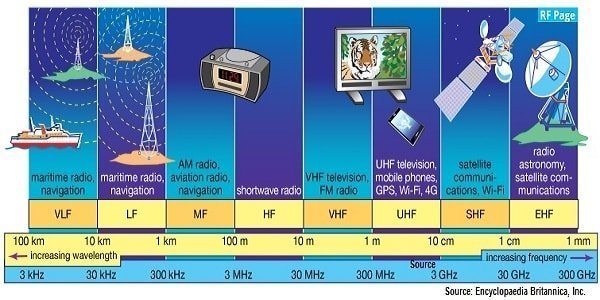Waves and Frequency Ranges

- Home
- /
- POSTS
- /
- Technology
- /
- Waves and Frequency Ranges
The spectrum of electromagnetic waves has frequencies up to 1024 Hz. This very large range is subdivided into different subranges due to different physical properties.
The subdivision of the frequencies into the different ranges was previously measured according to criteria that were historically developed and are now obsolete, and so a new classification of the frequency bands was created. This new classification could not yet fully established internationally.
The traditional frequency band designation is often still used in the literature. In NATO the new subdivision is used.
The following graphic shows an overview:

Figure 1: Waves and frequency ranges used by radar.
The frequencies of radar sets today range from about 5 megahertz to about 130 gigahertz (130,000,000,000 oscillations per second!). However, certain frequencies are also preferred for certain radar applications. Very long-range radar systems usually operate at lower frequencies below and including the D-band. Air traffic control radars at an airport operate below 3 GHz (ASR) or below 10 GHz (PAR).
C- Band (UHF- Radar)
For this frequency band (300 MHz to 1 GHz), specialized radar sets have been developed which are used as military early warning radar, for example for the Medium Extended Air Defense System (MEADS), or as wind profilers in weather observation. These frequencies are damped only very slightly by weather phenomena and thus allow a long-range. Newer methods, so-called ultrawideband radars, transmit with very low pulse power from the A to the C band and are mostly used for technical material investigation or partly in archaeology as Ground Penetrating Radar (GPR)
D- Band (L-Band Radar)
This range is ideally suited for modern long-range air surveillance radars up to a range of 250 nautical miles (≈400 km). Relatively low interference from civil radio communication services enables broadband radiation with very high power. They transmit pulses with high power, wide bandwidth and an intrapulse modulation to achieve even longer ranges. Due to the curvature of the earth, however, the range that can be practically achieved with these radar sets is much smaller at low altitudes, since these targets are then obscured by the radar horizon.
E/F-Band (S-Band Radar)
In the frequency band from 2 to 4 GHz the atmospheric attenuation is higher than in the D-band. Radar sets require a much higher pulse power to achieve long-ranges. An example is the older one military Medium Power Radar (MPR) with up to 20 MW pulse power. In this frequency band, considerable impairments due to weather phenomena are already beginning to occur. Therefore a couple of weather radars work in E/F-Band but more in subtropic and tropic climatic conditions, because here the radar can see beyond a severe storm.
G- Band (C-Band Radar)
For this frequency band mobile military battlefield radars with short and medium range are used. The antennas are small enough to be quickly installed with high precision for weapon control. The influence of weather phenomena is very large, which is why military radar sets are usually equipped with antennas with circular polarization. In this frequency range, most weather radars are also used for moderate climates.
I/J- Band (X- and Ku- Band Radars)
Between 8 and 12 GHz, the ratio of wavelength to antenna size has a more favorable value. With relatively small antennas, sufficient angular accuracy can be achieved, which favours military use as airborne radar. On the other hand, the antennas of missile control radar systems, which are very large relative to the wavelength, are still handy enough to be considered as deployable.
This frequency band is mainly used in civil and military applications for maritime navigation radar systems. Small cheap and fast rotating antennas offer sufficient ranges with very good precision. The antennas can be constructed as simple slot radiators or patch antennas.
K- Band (K- and Ka- Band Radars)
As the emitted frequency increases, the attenuation in the atmosphere increases but the possible accuracy and range resolution increases too. Large ranges can no longer be achieved. Radar applications in this frequency range are, for example, airfield surveillance radar, also known as Surface Movement Radar (SMR) or (as part of) Airport Surface Detection Equipment (ASDE).
V-Band
Due to molecular scattering of the atmosphere the electromagnetic waves suffer a very strong attenuation. Radar applications are limited to a range of a few ten meters.
W-Band
Two phenomena of atmospheric attenuation can be observed here. A maximum of attenuation at about 75 GHz and a relative minimum at about 96 GHz. Both frequencies are used practically. At about 75 to 76 GHz, short-range radar sets are used in automotive engineering as parking aids, brake assist systems and automatic accident avoidance.
N-Band
In the 122 GHz range there is another ISM band for measurement applications. Since in high-frequency technology the Terahertz range is defined from 100 GHz = 0,1 THz to 300 GHz, the industry offers radar modules for this frequency range as “Terahertz radar”. These Terahertz radar modules are used, for example, in so-called full-body scanners.








